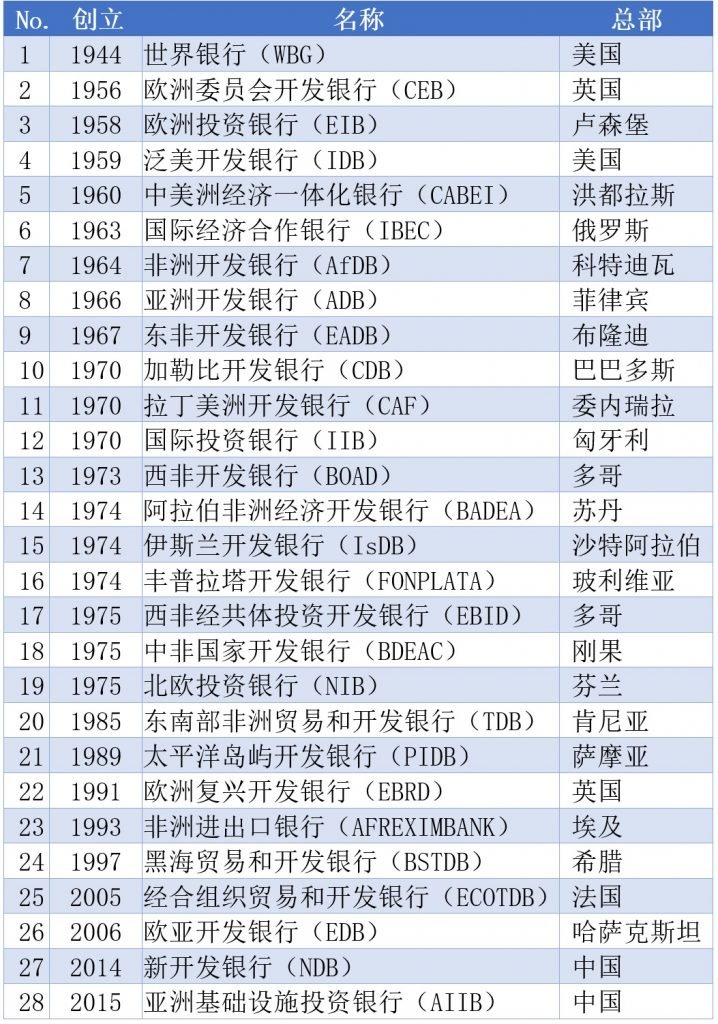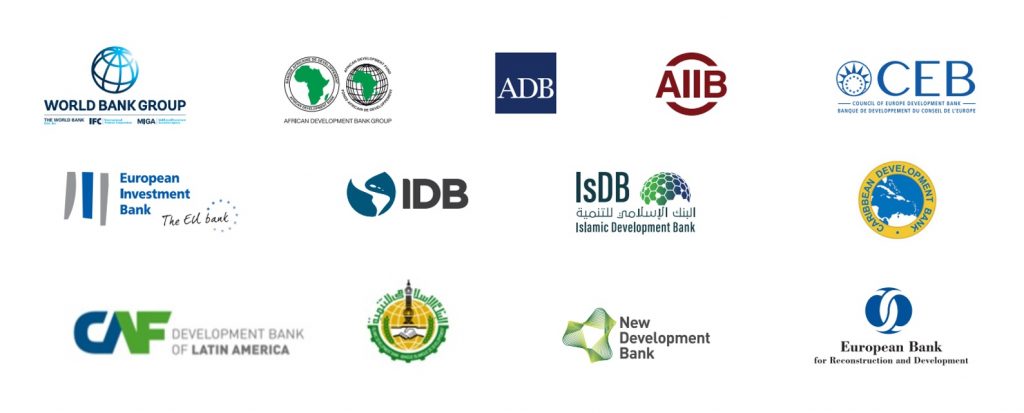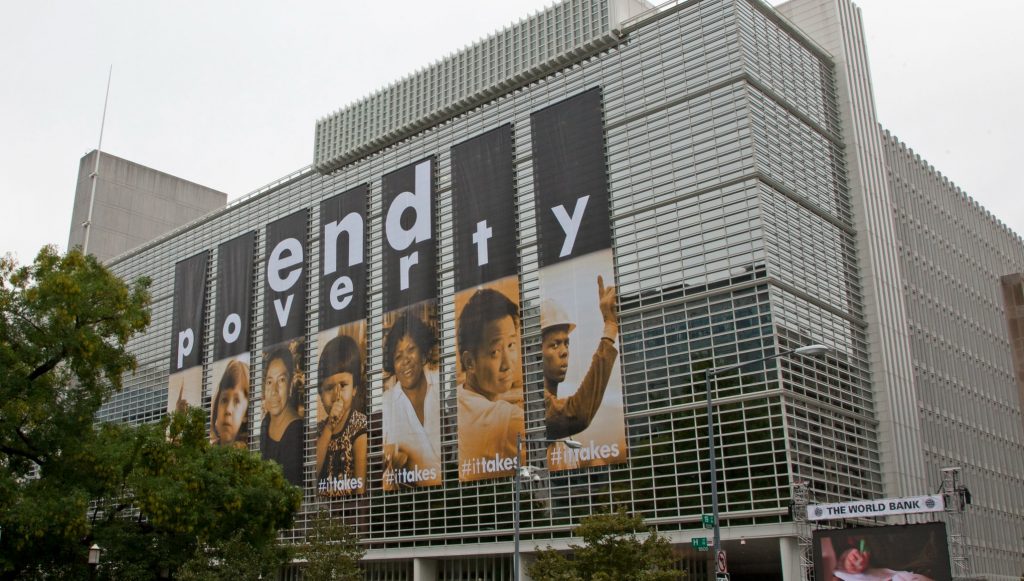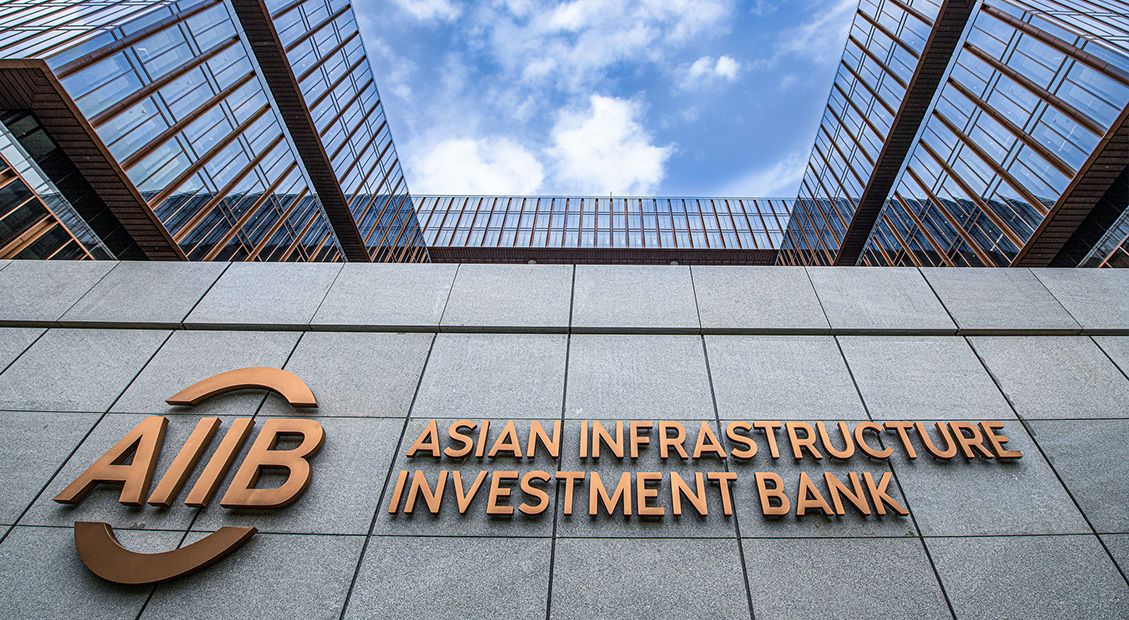Author: Julia Sun
There are about thirty multilateral development banks (MDBs) in the world. Among them, the major “traditional” multilateral development banks such as the World Bank, Asian Development Bank, African Development Bank, European Investment Bank and Inter-American Development Bank are well known. In contrast, multilateral development banks, mostly dominated by borrowing countries, are less well-known. As global challenges intensify, bringing borrower-country-led multilateral development banks into the mainstream international development agenda and strengthening their capacity can help strengthen the global capacity to address them.
What are borrowing country-led multilateral development banks?
According to the geographical scope of business coverage, multilateral development banks are traditionally divided into three types: global, regional and sub-regional. In recent years, with the emergence of new multilateral development banks, traditional geographic classifications have become less comprehensive. For example, the Latin American Development Bank (CAF) and the Trade and Development Bank (TDB) have expanded their membership far beyond their original "sub-regional" confines. At the same time, these development banks are very different from the "regional" Inter-American Development Bank (IDB) and African Development Bank (AfDB). The Asian Infrastructure Investment Bank (AIIB) and the New Development Bank (NDB) established in recent years are open to all countries in the world, but they are also significantly different from the World Bank.
According to institutional governance structure, multilateral banks can be divided into traditional multilateral development banks led by developed countries and multilateral development banks led by borrowing countries. Due to the systematic differences in the policy priorities and interest demands of the governments of borrowing countries and non-borrowing countries, there are also systematic differences between multilateral development banks led by borrowing countries and traditional multilateral development banks led by developed countries. Borrower-led multilateral development banks are usually initiated and controlled by emerging market countries. Different governance backgrounds lead to significant differences in operations between borrower-led multilateral development banks and traditional multilateral development banks.
Do you know these multilateral development banks?

Source: Organized by the author
What are the challenges facing borrowing country-led MDBs?
Borrower-led multilateral development banks are extremely attractive to emerging economies.Some emerging market economies find it attractive to establish a cooperative development institution that reflects their national interests, reducing the constraints imposed by developed donors in traditional multilateral development banks. Multilateral development banks led by borrowing countries usually have a deep understanding of the actual situation of emerging market economies, have close relationships with member governments, and actively respond to government needs, rather than imposing different development visions on others. As a result, some commentators believe that borrower-led multilateral banks are well adapted to the changing geopolitical environment, providing support for emerging market economies to develop relationships and jointly solve practical problems.
MDBs, led by most borrowing countries, are small but growing rapidly.Between 2000 and 2021, the ten borrower-led multilateral development banks' outstanding loan portfolio grew by a whopping 920% from $7.2 billion to $73.4 billion. Among them, the Latin American Development Bank (CAF), the Central American Bank for Economic Integration (CABEI), the African Export-Import Bank (Afreximbank), the Trade and Development Bank (TDB) and the Central American Bank for Economic Integration (CABEI) are five multilateral development banks. contributed to the major growth. The Black Sea Trade and Development Bank (BSTDB) and the Eurasian Development Bank (EDB) saw smaller increases. The Economic Community of West African States Investment and Development Bank (EBID) and the East African Development Bank (EADB) are still very limited.

(IDO/Graph)
Borrower-led multilateral development banks still face multiple challenges.Multilateral development banks provide loans for development projects and are attractive to borrowing countries when the terms of the loan are better than other sources of financing. Most traditional multilateral development banks have the highest credit rating of AAA, and can issue bonds at relatively low prices in the international capital market. Therefore, traditional multilateral development banks such as the World Bank can provide loans with preferential terms for development projects in borrowing countries at relatively low cost. However, the financing cost of multilateral development banks led by most borrowing countries is higher than that of traditional multilateral development banks. Although the cost of obtaining funds for multilateral development banks led by borrowing countries has been reduced in recent years, some multilateral development banks led by borrowing countries have low credit ratings and are still considered relatively risky by bond market investors. Overall, it is still a challenge for multilateral development banks led by borrowing countries to obtain low-cost funds, and the cost of financing is still much higher than that of traditional multilateral development banks.
The attractiveness of direct loans from borrowing country-led MDBs to governments when they can obtain more favorable financing terms from other official or commercial sources due to higher loan costs and shorter repayment periods is relatively limited. As a result, multilateral development banks led by some borrowing countries have shifted their focus to lending to the private sector.

(WBG/Image)
How can borrowing country-led multilateral development banks play a bigger role?
Bilateral aid agencies, traditional MDBs, international philanthropies, and impact investors can support borrower-country-led MDBs to play a greater role by supporting borrower-country-led MDBs to improve financing conditions and strengthen technical capabilities. For traditional multilateral development banks and bilateral aid agencies, it is necessary to encourage borrower country-led multilateral development banks to increase their development impact, but also to avoid imposing their own operating model on these banks from top to bottom.
There are three ways in which traditional multilateral banks, bilateral development agencies, and export finance institutions can support borrower country-led multilateral development banks:
One is to further provide low-interest long-term credit lines to support multilateral development banks led by borrowing countries.Traditional multilateral banks, bilateral development agencies, and export finance agencies have extended lines of credit to borrowing country-led multilateral development banks on varying terms. Most of these lines of credit are used for long-term development goals, and sometimes for short-term programs in response to crises, taking advantage of the local deployment capabilities of multilateral development banks. Multilateral development banks led by most borrowing countries have benefited from this. However, credit lines from bilateral aid agencies and traditional multilateral development banks are limited and could be substantially increased.
The second is to carry out joint project financing and support multilateral development banks led by borrowing countries to reduce business risks and improve credibility.Traditional MDBs can join projects initiated by borrowing country-led MDBs, and borrower country-led MDBs can provide additional financing for projects initiated by traditional MDBs. Co-financing can de-risk MDB loan portfolios, allowing them to finance larger projects, and boost external partners’ confidence in the credibility of borrowing-country-led MDBs. The move will also help support borrower-led multilateral development banks to improve project management and implementation.
The third is to strengthen coordination with multilateral development banks led by borrowing countries on the development agenda.Traditional multilateral development banks have been operating in member countries for many years and have strong relationships with local governments. They should strengthen coordination with multilateral development banks led by borrowing countries on the development agenda. Traditional multilateral banks and bilateral development agencies can support borrower-led multilateral development banks to cooperate in key areas identified by member countries, and comprehensively and systematically include borrower-led multilateral development banks in the agenda of addressing global challenges. Multilateral development banks led by borrowing countries have a better understanding of the needs of low- and middle-income developing countries, and can understand different development concepts and operating models through cooperation with traditional multilateral development banks.
References

All rights reserved, please indicate the source when citing.
